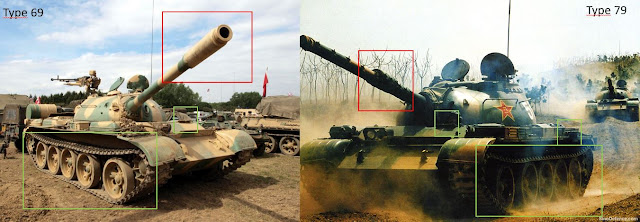The Chinese People's Liberation Army, that isn’t for the people and never liberates anyone, has a massive tank fleet that traces its lineage to the Soviet T-54 and T-72 tanks, but the recent iterations have taken a path of their own.
The oldest Chinese tanks in widespread PLA service are the pure T-55A derivatives Type 69 and Type 79. While these tanks are actively being phased out from service, they may still be encountered in remote areas and as replacements in a high attrition scenario.These share the 5 pairs of road wheels with spacing between the pairs increasing towards the front of the vehicle and a small rounded turret, typical for the Soviet tank designs. Both also have a rectangular exhaust port on the left side of the vehicle.
The largest external difference between the Type 69 and Type 79 is the cannon. The Type 69 uses the Soviet 100mm gun that has its bore evacuator positioned at the tip of its barrel, just like a T-55. The Type 79 on the other hand is equipped with a license built British 105mm cannon, that has the bore evacuator placed much closer to the barrel and the barrel profile also looks ribbed from afar. Both tanks have been upgraded in various programs and can mount a wide variety of applique and ERA armor layouts on top of the base tank.
Type 88 A and B share a strong lineage with the earlier tanks, but their hulls have been stretched and a sixth roadwheel pair has been added to the suspension. The roadwheel layout still follows the T-55 pattern with widening gaps between the wheels towards the front.
 |
| Type 88 |
Type 88:s use a domestic Chinese 105mm gun, instead of the British L7, but they are rather difficult to identify. Besides the road wheels, another easy identification point are the engine exhaust ports that have been moved to the right side of the tank and there are now two rounded ports quite widely separated instead of the Soviet style box
Type 96 is a further development of the Type 88 lineage, its original designation was the Type 88C. The plain T-96 has a more angular welded turret and a 125mm main gun. The turret shape is easily distinguishable from the earlier models.
 |
| Type 96 with a boxy turret front and a 125mm gun |
The Type 96A and B are a more radical departure from the Soviet tank design, by incorporating angular spaced armor elements at the turret front they resemble their contemporary western tanks. They also can and usually mount unitary looking ERA bricks on the hull and turret sides. But both still retain the same six-wheel T-55 inspired roadwheel layout and the driver position at the left side of the hull. The Type 96A retains the round exhaust ports on the right side of the hull, but the Type 96B moves the exhaust to the rear of the vehicle. Type 96B also usually has an electrical sensor on top of the barrel and a longer cross wind sensor mounting at the back of the turret.
The most modern MBT:s in the Chinese inventory are the Type 99 and Type 99A. While superficially similar to the later Type 96 models, they feature improved layouts that differ significantly between the Type 99 and 99A. Both have six roadwheels. While the Type 99 packs them in three distinct pairs, front and read packed tightly and the middle ones more loosely, the Type 99A has more evenly spaced roadwheels resembling the layout on the Russian T-72 and T-90 tanks.
The Driver's hatch was moved from center left to center right during the update. Type 99A also features longer skirts that cover almost half of the roadwheel. The ERA elements at the rear sides of the turret are also significantly longer on the Type 99A. Turret front The commander's optic on the Type 99A is more streamlined than the Type 99. Both retain the rear exhaust, but Type 99 exhaust pipes are angled downwards.
 |
| Type 98 |
The last tank in the PLA service is the Type 98 that served as a prototype series for the Type 99. Its most distinguishable feature is the T-80 inspired paired roadwheel layout and a less aggressively shaped rearwards angled turret front.
Far bigger unknown factor than the tanks is the training and leadership level of the PLA armored units. The Russian Army considered Chinese to be inferior in combined arms and armored warfare. Looking at the problems Russian army has had in Ukraine doesn't bode well for the Chinese in high intensity peer warfare.




I really enjoyed you blog and thank you for your contribution to this blog, which provided me with valuable information about bore evacuator. TankHistoria also has given details what is The Lump in a Tank’s Barrel. To know more vital information about it please click on the given link.
ReplyDeleteDesign meets defense. While exploring the Quick Guide to Chinese PLA Tanks, I couldn’t help but notice how each tank has its own identity structured, bold, and built with intent. As a professional graphic designer, that precision inspires me. Just like these machines, a powerful design isn’t just about appearance—it’s about purpose, impact, and clarity
ReplyDeleteHonestly, this was such an interesting breakdown. I never thought I would actually understand the differences between all these PLA tank models, but your explanations made it feel super simple to follow. I remember coming across a similar comparison while I was working on a project and I had to double-check the turret shapes like three times to be sure. Your post would have saved me so much stress back then. By the way, if anyone is studying this stuff academically, I personally know how helpful the professional nursing dissertation writing service type of support can be in managing heavy topics.
ReplyDelete